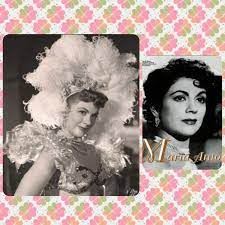MARÍA ANTONIETA PONS, ACTRIZ, BAILARINA, UNA DE LAS RUMBERAS CUBANAS EN LA ÉPOCA DE ORO DE MÉXICO. VIDEOS. FOTOS
María Antonieta Pons nació en La Habana el 11 de julio de 1922 y fue una actriz de cine y bailarina mexicana de origen cubano. En la Época de Oro del cine mexicano, fue la primera actriz en las películas de Rumberas en las décadas de 1940 y 1950. Fue conocida por Teatro del Crimen (1957), La vida íntima de Marco Antonio y Cleopatra (1947) y Romance en Puerto Rico (1962) entre las muchas películas de su dilatada carrera.
CARRERA ARTÍSTICA
MARIA ANTONIETA PONS inició su carrera como bailarina en Cuba en numerosos teatros y centros nocturnos. A los 16 años conoció al actor y director de cine español Juan Orol, quien se convirtió en su pareja en varios concursos de baile de la isla. Después de convertirse en esposa de Orol, él la llevó a México para que pudiera actuar en películas.
María Antonieta Pons debutó en el Cine de México en la película Siboney (1938). Después de su debut en esta película, María Antonieta actuó con Orol en giras internacionales de baile en Estados Unidos, particularmente en Nueva York y Chicago. A finales de 1943 Pons vuelve al cine, invitado por el productor Guillermo Calderón para actuar en la película Noches de Ronda, junto a los actores Susana Guizar y Ramón Armengod. En el mismo año, actuó en la película Red Konga junto a Pedro Armendáriz.
Finalmente, Pons volvió a las películas de Orol con Cruel destino. Cuando aún era empleado de Orol, Pons comenzó a rodar otras películas con otros directores. Lo más destacado de estas películas es ¡Viva mi desgracia! (1944), con Pedro Infante; Balajú (1944), junto a Katy Jurado; y Rosalinda (1945), con Rafael Baledón, entre otros. Su última película con Orol fue Pasiones tormentosas (1946).
VIDEOS- MARIA ANTONIETA PONS EN ESCENA…
Tras su ruptura con Orol, Pons fue contratada por el productor de cine Gregorio Wallerstein. De la mano de Wallerstein, filmó películas como La reina del trópico (1946); La vida íntima de Marco Antonio y Cleopatra (1946), con el actor argentino Luis Sandrini y dirigida por Roberto Gavaldón; La sin ventura (1947); Ángel o demonio (1947) y Los bien pagados (1948), entre otros. En 1949 actuó en la segunda versión cinematográfica de La mujer del puerto (la primera versión la realizó la actriz Andrea Palma en 1934), dirigida por Tito Davison.
Pons conoció a su segundo marido, el actor y director Ramón Pereda en 1950 cuando la contrató para rodar El ciclón del Caribe. Pons y Pereda se casaron poco después. Con Pereda como director, Pons realizó películas como La reina del mambo (1950), María Cristina (1950), La niña popoff (1952) y Casa de perdición (1954), entre otras.
En 1952 ingresó al mercado brasileño con la película Carnaval Atlántida. En la década de 1950 tuvo famosas colaboraciones cinematográficas con Evangelina Elizondo en ¡Que bravas son las costeñas! (1955); Antonio Espino Clavillazo en Nunca me hagan eso (1956); y con Germán Valdés “Tin Tan” en Teatro del crímen (1956), Las mil y una noches (1957), La Odalísca núm. 13 (1957) y Una estrella y dos estrellados (1959). Pons comenzó alternando actuaciones en cine con representaciones en los principales teatros de la Ciudad de México, como La Margo (hoy Blanquita) o el Follies Bergere.
SE RETIRA MARIA ANTONIETA PONS
Con el ocaso de las películas rumberas, Pons se retiró del cine a principios de los sesenta. Su última película fue Caña brava (1965), junto al cantor Javier Solís.
Después de Caña Brava, las apariciones públicas de Pons fueron limitadas. Aparecieron especulaciones sobre la ubicación de su residencia: se han propuesto Los Ángeles, Miami y Nueva York. A partir de la década de 1970, se negó a tener contacto con el público. Cuando murió su marido Ramón Pereda, su aislamiento fue mayor. Incluso se negó a recibir un Premio Diosa de Plata. Su razón fue: Todo lo que se puede decir de mí, se reflejó en mis películas. Tras la muerte de Ramón Pereda, se volvió a casar en 1989, esta vez con Benjamín Álvarez.
VIDA PERSONAL
Cónyuge: Benjamín Álvarez (m. 1989–2004), Ramon Pereda (m. 1950–1986), Juan Orol (m. 1940–1945)
Le sobrevive su única hija, María Guadalupe Pereda, de su segundo matrimonio.
María Antonieta Pons murió en la Ciudad de México el 20 de agosto de 2004. Pons había comenzado a tener lapsus mentales, pero un infarto le provocó la muerte. A petición suya, se anunció su muerte una vez concluidos los servicios funerarios. En varias entrevistas, su viudo negó que Pons tuviera sobrepeso y sostuvo que conservaba la escultural figura que la caracterizaba en sus películas.
FILMOGRAFIA
Seleccion de sus peliculas
¡Que bravas son las costeñas! (1955)
La engañadora (1955)
La culpa de los hombres (1956)
Teatro del crimen (1956)
Nunca me hagan eso (1956)
La odalisca no. 13 (1957)
La Odalisca No. 13 (1957)
Ferias de México (1957)
A Thousand and One Nights (1958)
It Happened in Mexico (1958)
Los legionarios (1958)
La flor de la canela (1959)
Acapulqueña (1959)
Una estrella y dos estrellados (1960)
Las cuatro milpas (1960)
Voy de gallo (1961)
El centauro del norte (1961)
Romance in Puerto Rico (1962)
Caña Brava (1964)
MARIA ANTONIETA PONS, ACTRESS, DANCER, ONE OF THE CUBAN RUMBERAS IN MEXICO FILM GOLDEN ERA. PHOTOS
Maria Antonieta Pons was born in Havana on July 11, 1922, and was a Cuban-born Mexican film actress and dancer. In the Golden Age of Mexican cinema, she was the first actress in the Rumberas films in the 1940s and 1950s. She was known for Teatro del Crimen (1957), La vida íntima de Marco Antonio y Cleopatra (1947), and Romance en Puerto Rico (1962) among of the many films on her long career.
ARTISTIC CAREER
MARIA ANTONIETA PONS began her career as a dancer in Cuba in numerous theaters and nightclubs. When she was 16, she met the Spanish actor and film director Juan Orol, who became her partner in various dance competitions on the island. After becoming Orol’s wife, he took her to Mexico so she could act in films.
María Antonieta Pons debuted in the Cinema of Mexico in the film Siboney (1938). After her debut in this film, Maria Antonieta performed with Orol on international dance tours in the United States, particularly in New York and Chicago. Towards the end of 1943, Pons returned to film, invited by the producer Guillermo Calderon to act in the film Noches de Ronda, along with the actors Susana Guizar and Ramon Armengod. In the same year, she performed in the film Red Konga beside Pedro Armendáriz.
Eventually, Pons returned to Orol’s films with Cruel destino. While still an employee of Orol, Pons began shooting other films with other directors. Highlights from these films are ¡Viva mi desgracia! (1944), with Pedro Infante; Balajú (1944), along with Katy Jurado; and Rosalinda (1945), with Rafael Baledón, among others. Her last film with Orol was Pasiones tormentosas (1946).
After her break with Orol, Pons was hired by the film producer Gregorio Wallerstein. Under the guidance of Wallerstein, she filmed movies like La reina del trópico (1946); La vida íntima de Marco Antonio y Cleopatra (1946), with the Argentine actor Luis Sandrini and directed by Roberto Gavaldón; La sin ventura (1947); Ángel o demonio (1947) and The Well-paid (1948), among others. In 1949, she performed in the second film version of La mujer del puerto (the first version was realized by the actress Andrea Palma in 1934), directed by Tito Davison.
Pons met her second husband, the actor, and director Ramón Pereda in 1950 when he contracted her to film El ciclón del Caríbe. Pons and Pereda married soon after. With Pereda as director, Pons made films like La reina del mambo (1950), María Cristina (1950), La niña popoff (1952) and Casa de perdición (1954), among others.
In 1952 she joined the Brazilian market with the film Carnaval Atlántida In the 1950s, she had famous film collaborations with Evangelina Elizondo in ¡Que bravas son las costeñas! (1955); Antonio Espino Clavillazo in Nunca me hagan eso (1956); and with Germán Valdés “Tin Tan” in Teatro del crímen (1956), Las mil y una noches (1957), La Odalísca no. 13 (1957), and Una estrella y dos estrellados (1959). Pons began alternating performances in films with performances in major theaters in Mexico City, like The Margo (today Blanquita) or the Follies Bergere.
MARIA ANTONIETA PONS RETIRES
With the decline of the Rumberas films, Pons retired from the cinema in the early sixties. Her last film was Caña brava (1965), alongside the singer Javier Solís.
After Caña Brava, Pons’s public appearances were limited. Speculation regarding the location of her residence appeared: Los Angeles, Miami, and New York have been proposed. Starting in the 1970s, she refused to have contact with the public. When her husband Ramon Pereda died, her isolation was higher. She even refused to receive a Diosa de Plata Award. Her reason was: All that can be said of me, was reflected in my films. After the death of Ramon Pereda, she remarried in 1989, this time to Benjamin Alvarez.
PERONAL LIFE
Spouse: Benjamín Álvarez (m. 1989–2004), Ramon Pereda (m. 1950–1986), Juan Orol (m. 1940–1945)
She is survived by her only daughter, Maria Guadalupe Pereda, from her second marriage.
María Antonieta Pons died in Mexico City on 20 August 2004. Pons had started to have mental lapses, but a heart attack caused her death. At her request, her death was announced after the funeral services had concluded. In several interviews, her widower denied that Pons was overweight, and held that she kept the statuesque figure that characterized her in her films.
(READ MARIA ANTONIETA PONS FILMOGRAPHY IN THE SPANISH SECTION ABOVE)
Agencies/ Wiki/ MariaAntonietaPonsBio./ Extractos/ Excerpts/ Internet Photos/ YouTube/ Arnoldo Varona/ www.TheCubanHistory.com
THE CUBAN HISTORY, HOLLYWOOD.



 MARIA Antonieta Pons, Actrees, Dancer, one of the Cuban Rumberas in México Film Golden Era. VIDEOS.* MARIA ANTONIETA PONS, Actress, Dancer, and one of the Cuban Rumberas in Mexico Film Golden Era. PHOTOS.
MARIA Antonieta Pons, Actrees, Dancer, one of the Cuban Rumberas in México Film Golden Era. VIDEOS.* MARIA ANTONIETA PONS, Actress, Dancer, and one of the Cuban Rumberas in Mexico Film Golden Era. PHOTOS.





